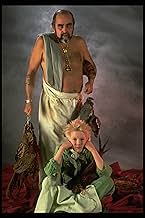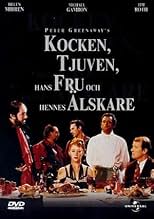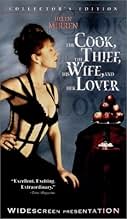El cocinero, el ladrón, su esposa y su amante
Título original: The Cook, the Thief, His Wife & Her Lover
La esposa de un criminal abusivo encuentra consuelo en los brazos de un hombre que visita regularmente el restaurante de su esposo.La esposa de un criminal abusivo encuentra consuelo en los brazos de un hombre que visita regularmente el restaurante de su esposo.La esposa de un criminal abusivo encuentra consuelo en los brazos de un hombre que visita regularmente el restaurante de su esposo.
- Premios
- 7 premios ganados y 11 nominaciones en total
Ciarán Hinds
- Cory
- (as Ciaran Hinds)
Roger Ashton-Griffiths
- Turpin
- (as Roger Ashton Griffiths)
- Dirección
- Guionista
- Todo el elenco y el equipo
- Producción, taquilla y más en IMDbPro
Opiniones destacadas
The "inside story" of this film is color. Most professional reviewers, with nation-wide media exposure, missed this underlying story element entirely, as did I, until half way through my first viewing. Once I realized the colors of the costumes changed, as the characters passed from room to room, I had to go back and see it again. That's how I got hooked.
During the next viewing, I took note of the creativity and effort that went into the design and construction of the costumes, several times, as each one had to be rendered in several colors. The next time through, I noticed how the color of each room related to the activity that normally took place there, even in the outdoor sequences. With the subsequent viewing, I concentrated on the soundtrack.
From that point on, my awareness of all these elements, served to enhance my appreciation of each character and his or her contribution to the story line. That's when the much talked about "gross-out" aspects of the film seemed to diminish in their ability to shock. In fact, by that point, they seemed to fit much more naturally, although the "NC-17" rating is absolutely appropriate.
This is a sumptuous feast for the eyes and ears of intelligent "adult" viewers. Not to be missed.
During the next viewing, I took note of the creativity and effort that went into the design and construction of the costumes, several times, as each one had to be rendered in several colors. The next time through, I noticed how the color of each room related to the activity that normally took place there, even in the outdoor sequences. With the subsequent viewing, I concentrated on the soundtrack.
From that point on, my awareness of all these elements, served to enhance my appreciation of each character and his or her contribution to the story line. That's when the much talked about "gross-out" aspects of the film seemed to diminish in their ability to shock. In fact, by that point, they seemed to fit much more naturally, although the "NC-17" rating is absolutely appropriate.
This is a sumptuous feast for the eyes and ears of intelligent "adult" viewers. Not to be missed.
First of all, I have to say that this film is one of my personal favorites, and that it is one of those things one must see during his or her lifetime.
Truthfully, however, I first got into this film after hearing clips of the soundtrack on the Japanese version of Iron Chef, during a time before it was acquired by the Food Network. This film score, composed by the great post-minimalist Michael Nyman, is still one of the most haunting and soul-stirring scores in my opinion, if not the one of the most impressionable bodies of musical work ever. I still listen to the album on a weekly basis - it gets under your skin that way.
The film itself is a piece of total art, as others have said. The sets are saturated with their singular color schemes (blue for the restaurant's exterior, green for the kitchen, white for the restrooms, and red for the main dining hall) , and people who have any sort of artistic training have valued and will continue to value this film as a character study of color. In this present age where most films present their interpretations of visual thrill through costly CG and SFX technologies, this film is a testament to how color can be a driving influence behind effective set design and cinematography.
The principal actors, including the always amazing Helen Mirren and Michael Gambon, are first rate. Helen Mirren's Georgina is a truly heart-wrenching character, especially in the face of Gambon's portrayal of Albert Spica, a poor excuse for a human being and one of cinema's cruelest villains. The cook and lover are merely catalysts, serving to instigate the final act that is the undoing of Albert's overreaching tyranny.
I suppose the anti-Thatcher sentiment is highly applicable to this film, but since I am not a British citizen, I feel that I cannot comment on this. However, I think the film's allegory can also be applied to other scenarios where a brutish figure uses violence and exploitation as a way to control others whose primary fault is only residing in the same physical/social/legal domain as the brute.
In short, a masterpiece.
Truthfully, however, I first got into this film after hearing clips of the soundtrack on the Japanese version of Iron Chef, during a time before it was acquired by the Food Network. This film score, composed by the great post-minimalist Michael Nyman, is still one of the most haunting and soul-stirring scores in my opinion, if not the one of the most impressionable bodies of musical work ever. I still listen to the album on a weekly basis - it gets under your skin that way.
The film itself is a piece of total art, as others have said. The sets are saturated with their singular color schemes (blue for the restaurant's exterior, green for the kitchen, white for the restrooms, and red for the main dining hall) , and people who have any sort of artistic training have valued and will continue to value this film as a character study of color. In this present age where most films present their interpretations of visual thrill through costly CG and SFX technologies, this film is a testament to how color can be a driving influence behind effective set design and cinematography.
The principal actors, including the always amazing Helen Mirren and Michael Gambon, are first rate. Helen Mirren's Georgina is a truly heart-wrenching character, especially in the face of Gambon's portrayal of Albert Spica, a poor excuse for a human being and one of cinema's cruelest villains. The cook and lover are merely catalysts, serving to instigate the final act that is the undoing of Albert's overreaching tyranny.
I suppose the anti-Thatcher sentiment is highly applicable to this film, but since I am not a British citizen, I feel that I cannot comment on this. However, I think the film's allegory can also be applied to other scenarios where a brutish figure uses violence and exploitation as a way to control others whose primary fault is only residing in the same physical/social/legal domain as the brute.
In short, a masterpiece.
I sat transfixed by this film's ability to become increasingly depraved, always without any redeeming quality whatsoever. We would have left except that I became fascinated by the ability of the director and writer to hit bottom and then keep drilling. The story is familiar enough but there are no protagonists. There really are no antagonists either. Just a bunch of people you care nothing about doing things you don't want to know about. If a friend did this stuff to another human and wanted to tell you about it, you would scream for him/her to stop.
To top it off it has a score by Michael Nyman who had just enough talent to write one bad film score and retreads it for every film that a producer is stupid enough to hire him to score.
To top it off it has a score by Michael Nyman who had just enough talent to write one bad film score and retreads it for every film that a producer is stupid enough to hire him to score.
I saw this almost fifteen years ago and I still have crystal clear mental images of some of the scenes. The chef at his table in the kitchen, planning his menu: stunning! Put it in a frame, hang it on the wall. In the restaurant scenes, you feel like you're there at the table as the camera pans, without cuts, from one person to another. Our heroes locked in the truck full of rotting meat: horrible, disgusting, perfect. It's a classic purification ritual and it's literally putrid. Greenaway is a genius. My only criticism is a minor one. There is a full frontal nude scene of the wife and her lover, where he is clearly more "relaxed" than he should have been at that moment. I'm a bit disappointed in Greenaway for not showing him at "attention", as he would have been in real life. But then, I guess he would have been accused of making porn. Whatever. This film is not for everyone. My wife didn't see it. I'm sure she would have hated it if she had. For that matter, I can't actually say I liked it, although I consider it a masterwork. But I'm glad I saw it. I'll probably see it again, but not until I can see it on HDTV. Plain old DVD couldn't possibly do it justice. An amazing movie.
10miloc
Here's the weird secret of this movie: you might actually enjoy it.
Peter Greenaway once commented, "film is too important to be left in the hands of story- tellers." Like almost everything Godard ever said, it's a preposterous statement that ought to be heeded.
As a filmmaker Greenaway has always delighted in puzzle-pictures; from the twin-based symmetry of "A Zed and Two Naughts" to the subliminal counting-game of "Drowning by Numbers" to the mad frames-within-frames of "Prospero's Books" his films resemble nothing so much as one of Graeme Base's wonderful children's' books ("The Eleventh Hour" and "Animalia" for instance) brought to life. Plus, of course, a great deal of nudity and assorted nastiness-- enough to get the works of one of the most original filmmakers living a rather sordid reputation.
So, once you've recovered from the visceral shock of watching "The Cook, the Thief, His Wife and Her Lover" the first time, take a step back and watch it again. Yeah, I mean that, do it. Look at it this time as you might a painting by Heironymus Bosch: what appears to be a madman's chaotic hellscape turns out to have a precise allegorical order, and contains such a wealth of symbolism that one viewing cannot possibly be enough to absorb it all. A scene that may seem gratuitously horrific (a naked couple enclosed in a truck full of rotting meat-- probably the moment that jolted me the most) in fact reveals a medievalist's precision (Adam and Eve, cast from Paradise for the First Big Sin, are suddenly subject to the corruption of the flesh). An abstract concept is thus made perfectly and accessibly literal.
Different viewers may prefer to see this movie as religious allegory, political screed, or wry class commentary. The fact is it is all of these, and probably more. The irony of Greenaway's quote above is that he is in fact story-telling on several levels at once. (It's the same irony in the comment that "Seinfeld" was a "show about nothing" when in fact there was more going on per episode than in any other ten sitcoms. It just wasn't "simple.")
In response to criticism over the bloodshed in his movies, Godard once said "It isn't blood, it's red." Meaning: it's all part of a composition, the way color is used on a painter's canvas. It's there for a point, just like Greenaway's explicit yet elegant shocks. With that mind, watch this movie, and enjoy it. It's sharp, gruesomely witty, and as remarkable to look at as almost anything in the Met. If you can handle really thinking, you can handle this, and we all can, can't we?
Peter Greenaway once commented, "film is too important to be left in the hands of story- tellers." Like almost everything Godard ever said, it's a preposterous statement that ought to be heeded.
As a filmmaker Greenaway has always delighted in puzzle-pictures; from the twin-based symmetry of "A Zed and Two Naughts" to the subliminal counting-game of "Drowning by Numbers" to the mad frames-within-frames of "Prospero's Books" his films resemble nothing so much as one of Graeme Base's wonderful children's' books ("The Eleventh Hour" and "Animalia" for instance) brought to life. Plus, of course, a great deal of nudity and assorted nastiness-- enough to get the works of one of the most original filmmakers living a rather sordid reputation.
So, once you've recovered from the visceral shock of watching "The Cook, the Thief, His Wife and Her Lover" the first time, take a step back and watch it again. Yeah, I mean that, do it. Look at it this time as you might a painting by Heironymus Bosch: what appears to be a madman's chaotic hellscape turns out to have a precise allegorical order, and contains such a wealth of symbolism that one viewing cannot possibly be enough to absorb it all. A scene that may seem gratuitously horrific (a naked couple enclosed in a truck full of rotting meat-- probably the moment that jolted me the most) in fact reveals a medievalist's precision (Adam and Eve, cast from Paradise for the First Big Sin, are suddenly subject to the corruption of the flesh). An abstract concept is thus made perfectly and accessibly literal.
Different viewers may prefer to see this movie as religious allegory, political screed, or wry class commentary. The fact is it is all of these, and probably more. The irony of Greenaway's quote above is that he is in fact story-telling on several levels at once. (It's the same irony in the comment that "Seinfeld" was a "show about nothing" when in fact there was more going on per episode than in any other ten sitcoms. It just wasn't "simple.")
In response to criticism over the bloodshed in his movies, Godard once said "It isn't blood, it's red." Meaning: it's all part of a composition, the way color is used on a painter's canvas. It's there for a point, just like Greenaway's explicit yet elegant shocks. With that mind, watch this movie, and enjoy it. It's sharp, gruesomely witty, and as remarkable to look at as almost anything in the Met. If you can handle really thinking, you can handle this, and we all can, can't we?
¿Sabías que…?
- TriviaThe four title characters were named for the actors and actress writer and director Peter Greenaway originally wanted to play them. Richard (The Cook) was for Richard Bohringer, the only one of Greenaway's original choices retained in the final movie. Albert (The Thief) was named after Albert Finney, while Georgina (His Wife) was for Georgina Hale. Michael (The Lover) was named, interestingly enough, for Sir Michael Gambon, who Greenaway eventually re-cast as Albert.
- ErroresWhen Albert (Michael Gambon) goes into the ladies' toilet and starts throwing women out of the cubicles, the second one has, as you would expect, her underwear around her knees. But her skirt rides right up, revealing that she is still wearing her underwear and that the ones below are a prop.
- Créditos curiososClosing credits epilogue: "And a special thanks to those very many people who patiently & repeatedly performed as patients & nurses in the hospital ward, and as diners in the Hollandais Restaurant."
- Versiones alternativasAn edited, R-rated version is available on video.
Selecciones populares
Inicia sesión para calificar y agrega a la lista de videos para obtener recomendaciones personalizadas
Detalles
- Fecha de lanzamiento
- Países de origen
- Sitio oficial
- Idiomas
- También se conoce como
- The Cook, the Thief, His Wife & Her Lover
- Locaciones de filmación
- Productoras
- Ver más créditos de la compañía en IMDbPro
Taquilla
- Total en EE. UU. y Canadá
- USD 7,724,701
- Fin de semana de estreno en EE. UU. y Canadá
- USD 252,223
- 8 abr 1990
- Total a nivel mundial
- USD 8,527,316
- Tiempo de ejecución
- 2h 4min(124 min)
- Color
- Relación de aspecto
- 2.35 : 1
Contribuir a esta página
Sugiere una edición o agrega el contenido que falta


























